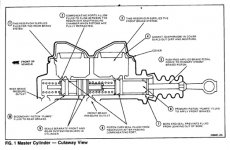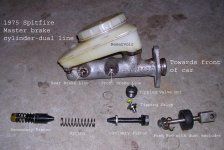John75
Freshman Member
Offline
I replaced my brake master cylinder-dual line today in my 75 spitfire with a new one, but I'm not getting any brake fluid when I try bleeding the rear brakes. Front brakes bleed good. I disconected the rear brake line at the master cylinder, and there isn't any fluid coming out of the master cylinder when the brake is depressed. Fluid is topped off. Am I missing something here? /ubbthreads/images/graemlins/confused.gif Is it possible that the new master cylinder is bad. Should the same amount of brake fluid come out of both the front and rear brake line connections at the master cylinder. If anyone has experience with this, I could use some guidance.
John
Newbie with a 75 Spitfire
John
Newbie with a 75 Spitfire

 Hi Guest!
Hi Guest!

 smilie in place of the real @
smilie in place of the real @
 Pretty Please - add it to our Events forum(s) and add to the calendar! >>
Pretty Please - add it to our Events forum(s) and add to the calendar! >> 


